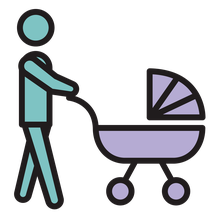Understanding your baby
Babies don’t come with a manual, but they work hard to tell you what they need.
An important part of learning about your baby is recognising and responding to when they are ready to play, sleep, cuddle, rest and feed.
Learning the 6 baby states
Your baby goes through different states of sleepiness and wakefulness throughout the day, these are called 'states'.
There are 6 baby states that help you understand what your baby might need.
Depending on your baby’s state, you may need to soothe them, switch to a different activity, or play with them.
Caring for a crying baby
One of the challenges of becoming a parent can be caring for a crying baby.
Your brain is designed to find your baby’s cry uncomfortable. This is nature’s way of telling us to try and cuddle, comfort and calm your baby.
Know that your baby isn’t trying to punish you, or that you aren’t a good enough parent. Lots of parents have these worries.
Crying is your baby’s way of communicating with you. It can be helpful to think about your baby’s cry as them trying to talk to you.
They may be trying to tell you that they need a nappy change, that they’re too hot or too cold, or that they are hungry.
Sometimes babies continue to cry even after you have checked these basics. Try to stay calm and reassure yourself that you are trying your best.

How to comfort a crying baby

Stroking
Talk calmly to your baby. Stroke them gently. Try placing your baby face down on your lap, or hold them against you and try stroking their back gently up and down.

Humming or singing
Hum or sing to your baby. Let them hear a repeating, constant and soothing sound. Classical music, including piano and guitar, can sometimes soothe some babies.

Going for a walk
Go outside with your baby and walk them in a pram or in a baby sling. The rocking motion can be very soothing for a baby. If you can’t go outside try a gentle rocking motion inside. Walk around whilst gently rocking your baby.

Sucking
Sucking can help relieve a baby’s crying. If offering the breast is not possible, a dummy can soothe a baby. This can be given after 4 weeks for babies who are breastfeeding, or at any time if the baby is formula fed.

Holding
Hold them close: skin to skin.

Bathing
Try giving them a warm bath.
Getting help with a crying baby
It can be difficult and tiring when trying to sooth a crying baby. Never shake or shout at a baby.
If you feel stressed and angry, put your baby in a safe place and walk away. After a few minutes, when you are feeling calm, go back and check on your baby.
If you are worried that your baby is crying because they are unwell, contact your doctor or get help from NHS 111 by calling 111.
For support with crying, you may find it helpful to talk to someone you trust like a family member or friend. You could also seek support from your health visitor or doctor.
You can also find additional support at:
- Cry-sis: Support for crying and sleepless babies provides a helpline free on 0800 448 0737. It's open 9am to 10pm, 7 days a week
- ICON Cope: Helping people who care for babies to cope with crying
Playing and talking with your baby
You may think your baby needs lots of new and exciting toys to play with. That’s not true, you are your baby’s favourite toy.
Your baby will love to look at your face, feel your skin, smell you, cuddle with you, be gently rocked, moved and held by you.
As soon as your baby is born they are ready to communicate with you. Babies want to look at human faces.
You can help them to feel safe by holding them close, talking to them, and comforting them.
They can't understand all you say but they will feel comforted when you talk and sing with them.
Find more fun activities you can do together with your baby.

Signs your baby needs a break
Your baby’s brain is making a million new connections every second. It’s understandable that they can easily become overwhelmed, tired, or stressed.
Watching your baby will help you learn when they need a break or a change in activity.
What to look out for:
- sneezing
- yawning
- hiccupping
- turning away
- closing their eyes
- bringing up some milk
What to do when they need a break
When you notice these signs, think about what might be overwhelming your baby and let them take a break.
Slow down the pace, stop the activity you are doing or move them to a quieter area. Or perhaps they are ready for a sleep or feed.
After a break your baby may be ready to take part in an activity again.
Interacting can take a lot of energy, so they might not be able to do it for more than a few minutes at a time.
As you build your bond, your instinct will kick in and you'll soon pick up more quickly on their cues.







